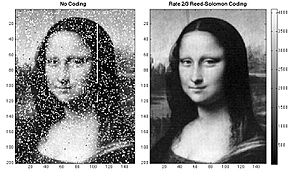Error detection and correction facts for kids
Error detection and correction is all about making sure that information or data doesn't get messed up when it's being sent or stored. Think of it like sending a message: you want to be sure the person who gets it reads exactly what you wrote, not something different! These special methods help deliver digital data safely, even when the way it's sent isn't perfect.
Contents
What are Data Errors?
When you send data, like a picture or a text message, it travels as tiny signals. Sometimes, these signals can get changed or lost. This can happen because of things like:
- Noise: Like static on a radio, which can mess up the signals.
- Interference: Other signals getting in the way.
- Weak signals: If the signal isn't strong enough, parts might disappear.
When data gets changed by accident, we call that an error. Errors can make a picture look glitchy, a video freeze, or a file not open at all.
How Computers Find Errors
To find errors, computers add extra information to the data. This extra information is called redundancy. It's like sending a message twice to make sure it's heard correctly. If the two messages are different, you know something went wrong!
There are many clever ways computers use redundancy to spot errors:
- Repetition codes: This is the simplest way. The computer sends the same piece of data several times. If it gets three copies of "hello" but one says "hallo", it knows there's an error.
- Parity bits: Imagine you have a group of numbers. A parity bit is an extra number added to make sure the total count of "1"s (in computer code) is either always even or always odd. If it's supposed to be even and it's odd, an error happened!
- Checksums: The computer adds up all the numbers in a block of data to get a special "checksum" number. This checksum is sent along with the data. The receiver does the same calculation. If their checksum doesn't match the one sent, they know there's an error.
- Cyclic redundancy checks (CRCs): This is a more advanced type of checksum. It's very good at finding common errors that happen during data transfer.
- Hamming codes: These are special codes that can not only detect errors but also help fix them.
How Computers Fix Errors
Once an error is found, there are two main ways to fix it:
Automatic Repeat Request (ARQ)
Imagine you're talking to a friend, and they say, "What did you say?" This is like ARQ.
- When the receiver detects an error, it simply asks the sender to send that part of the data again.
- This method is simple and works well, but it can slow things down if there are many errors or if the sender is far away.
- It's commonly used in things like Wi-Fi and TCP/IP (the rules for sending data over the internet).
Forward Error Correction (FEC)
With FEC, the data is sent with enough extra information that the receiver can fix many errors on its own, without asking the sender to resend anything.
- It's like sending a message with a secret code that also includes instructions on how to fix any smudges or missing letters.
- This method is great for situations where asking for a resend is difficult or impossible, like:
- Sending data to a spacecraft far away.
- Broadcasting television or radio signals.
- Reading data from a CD or DVD.
- A common type of FEC is called Reed-Solomon error correction, which is used in CDs, DVDs, and even in space communication!
Error detection and correction are super important for almost everything digital we use every day, from watching videos to sending emails and even exploring space!
See also
 In Spanish: Detección y corrección de errores para niños
In Spanish: Detección y corrección de errores para niños


